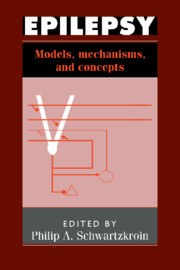Book contents
- Frontmatter
- Contents
- List of contributors
- General introduction
- Section 1 Chronic models in intact animals – concepts and questions
- Section 2 Features of the epileptogenic brain
- Introduction
- 6 Neurophysiological studies of alterations in seizure susceptibility during brain development
- 7 Electrophysiology and pharmacology of human neocortex and hippocampus in vitro
- 8 Cell death, plasticity, and epilepsy: insights provided by experimental models of hippocampal sclerosis
- 9 Sprouting as an underlying cause of hyperexcitability in experimental models and in the human epileptic temporal lobe
- 10 Rapidly recurring seizures and status epilepticus: ictal density as a factor in epileptogenesis
- Section 3 ‘Normal’ brain mechanisms that support epileptiform activities
- Recent advances
- Index
6 - Neurophysiological studies of alterations in seizure susceptibility during brain development
from Section 2 - Features of the epileptogenic brain
Published online by Cambridge University Press: 03 May 2010
- Frontmatter
- Contents
- List of contributors
- General introduction
- Section 1 Chronic models in intact animals – concepts and questions
- Section 2 Features of the epileptogenic brain
- Introduction
- 6 Neurophysiological studies of alterations in seizure susceptibility during brain development
- 7 Electrophysiology and pharmacology of human neocortex and hippocampus in vitro
- 8 Cell death, plasticity, and epilepsy: insights provided by experimental models of hippocampal sclerosis
- 9 Sprouting as an underlying cause of hyperexcitability in experimental models and in the human epileptic temporal lobe
- 10 Rapidly recurring seizures and status epilepticus: ictal density as a factor in epileptogenesis
- Section 3 ‘Normal’ brain mechanisms that support epileptiform activities
- Recent advances
- Index
Summary
Introduction
The basic processes responsible for seizures in an infant's brain are likely to be quite different from those in the central nervous system of an adult. The nervous system of a neonate is so unlike its mature counterpart in basic anatomical, physiological, and metabolic properties that it is obvious even to the most casual observer that many critical issues of pediatric epileptology are different from those addressed by epileptologists concerned with controlling seizures in adults.
Many epileptic syndromes in children occur during restricted phases of nervous system development (O'Donohoue, 1985; Aicardi, 1986; Tharp, 1987); the phrase ‘age-specific epilepsies’, therefore, has been used to describe these disorders. For example, infantile spasms are observed usually between three months and three years of age (Lacy & Penry, 1976). Thereafter this seizure disorder may evolve into a different form of epilepsy only later to emerge as another syndrome in adulthood. At each stage the seizures are likely to differ not only in their clinical and electrographic features but also in their response to medication (Freeman, 1987).
On the other hand some seizure disorders of childhood have clear counterparts in adulthood. Simple and complex partial seizures are examples (Holmes, 1986, 1987; Wyllie et al., 1989). Characteristically, these seizures arise from localized regions of the brain and are often referred to in experimental epilepsy research as focal seizures. In both infants and adults, the complex partial epilepsies commonly originate from the temporal lobe.
Information
- Type
- Chapter
- Information
- EpilepsyModels, Mechanisms and Concepts, pp. 209 - 243Publisher: Cambridge University PressPrint publication year: 1993
Accessibility standard: Unknown
Why this information is here
This section outlines the accessibility features of this content - including support for screen readers, full keyboard navigation and high-contrast display options. This may not be relevant for you.Accessibility Information
- 29
- Cited by
